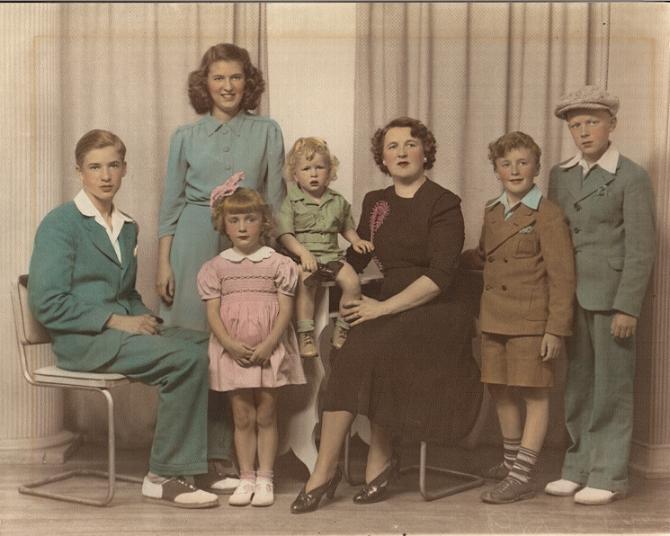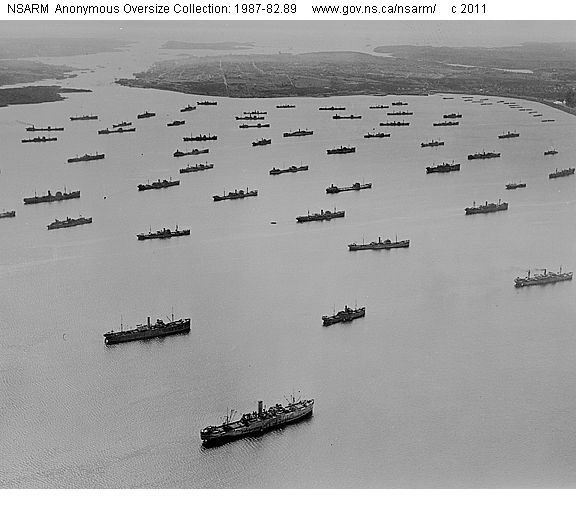Chapter Three, The No-Memory Years (1941-44)
I have no memories of my first few years of life. For the sake of the whole, though, I give a short narrative of the years through to 1944.
1942
The war, of course, was all in the background, and boldly so. While I was crawling around on a rug in the safety of a home far from the battle grounds, the Germans were turning Europe into a hell and the Japanese were doing the same in the east. At the first of 1942, Singapore fell to the Japanese. In February of that year, Port Darwin, in Australia's Northern Territory was bombed by the Japanese. As a toddler of 17 months, my fellow Canadians, in their soldier uniforms, were being riddled with efficient German machine guns on European beaches off of Dieppe. In the Pacific, the Americans sink four Japanese aircraft carriers at the Battle of Midway, which effectively stopped the Japanese offensive. On August 7th, the Americans landed on Guadalcanal, beginning the three-year island-hopping offensive against Japan.
1943
Hitler invaded Russia, as did Napoleon before him, misjudging the insurmountable odds in over-coming the two great Russian defences: its people and its climate. The mechanized army of Germany drove deep into Russian territory in short order, then the winter enveloped them and brought them to a stop just before Stalingrad. The German supply lines, the ones that were working, were long and slow. On February 2nd, the Battle of Stalingrad ended with the surrender of the German 6th Army. Just then, in northern Africa, German General Erwin Rommel and his Afrika Korps pushed against the American/British forces. As valiant as Rommel and his men were, by May 13th, the last of the German/Italian soldiers in North Africa surrendered to the Allies.
In July of 1943, an allied invasion fleet was pointed towards the southern shores of Sicily. The landings were made without resistance. Large numbers of the Seventh United States Army and the British Eighth Army including the 1st Canadian Infantry Division headed inland to do battle. Before the month was out, administrative and political support was withdrawn from Mussolini; Mussolini was arrested and the power was given to an Italian general with the goals of setting up a proper government and to make peace with the Allies (achieved by that October). So too, in July (the 28th) the British bombed Hamburg, causing a firestorm that killed 42,000 German civilians.
That August, the 14th, a conference was held at Quebec City; Canadian Prime Minister MacKenzie King met with Winston Churchill and Franklin D. Roosevelt. This was followed up in August, when, in November, Roosevelt, Churchill and Stalin met at Tehran. Within the month, U.S. Gen. Dwight D. Eisenhower was appointed to lead Allied invasion of Europe from the west.
Early in that year, 1943, American movie studio executives agreed to allow the Office of War Information to censor movies. In March, Rodgers and Hammerstein's Oklahoma opened on Broadway. It started a new kind of musical, and it became an instantaneous stage classic, and went on to be Broadway's longest-running musical up to that time (1943).

1943: Joe (13 yrs old), Lila (14), Nancy (6), Peter (2), Mum (Agnes), John (9) & Paul (12).
(One more child came along after this photo was taken: Linda, December 5th, 1944).
Island hopping was in full progress in the south-western Pacific. In February, American marines were busy capturing the Marshall Islands, at considerable expense. In March, in another part of the world, the Battle of Monte Cassino raged on, a struggle which took 20,000 lives. By May 18th, it was over with the Germans evacuating the bombed out ruins of the monastery. And then comes June, June 6th to be more precise, yet in another part of the world, the Battle of Normandy got a dramatic start under the code word, "Operation Overlord" (not that the public knew much until a considerable amount of time had passed). On the first day, D-Day, one hundred and fifty thousand Allied troops landed on the beaches of Normandy. The outcome of the largest amphibious assault force ever assembled when it came up against the Atlantic Sea Wall -- so well prepared by the Germans -- was not at all certain. Indeed, for awhile there, it went badly, especially for the Americans; and the matter, overall, was much in doubt; but, fortunately, the Germans held back their reserves too long. Within days, however, all the Allied Forces were making their way inland and the Western Front was well and truly established. By the 26th, the Americans entered Cherbourg. By July the 19th, the British and Canadian forces took Caen, but only after six weeks of positional warfare throughout Normandy. The Allies now wanted to advance beyond the hedgerows of Normany and fight the Germans on the relatively flat fields around the Falaise area. There was however a ridge of land, Verrières Ridge, which blocked a direct advance by the Allied forces to Falaise. The Canadians were ordered to take it. The Canadian assault was meant more to distract the Germans while the Americans to the west made their advance inland. However, the Germans were initially convinced that the Canadian advance was to be the principal breakout. Thus, the Germans were expecting this attack and consequently reinforced Verrières Ridge in the days just preceding the Canadian attack. By July 24, 480 tanks, 500 field guns, and four additional German infantry battalions were moved into the sector. This battle, code named "Operation Spring," in which the North Nova Scotia Highlanders (The North Novas) participated, ended up being one of the bloodiest days for the Canadians during the war; it resulted in 1,550 casualties, including 450 killed.
In order to bleed off German forces, the western front was something the Russians were long crying for. On June 22nd, the Russians opened up their offensive against the Germans in the eastern front. Within a month, on July 20th, German dissidents attempted to assassinate Hitler; it came to no good end.
On August 24, Paris was liberated without much of a struggle; it marked the successful end of "Operation Overlord." Next, was to advance directly to Germany and many thought the European war would be over before the end of the year; but, it was not to be, as the Germans fought like wildcats right to the end.
The Canadians advanced up the western coast of Europe. On September 1st, they captured the coastal town of Dieppe. On November 30th, the Canadians crossed the German border. On December 16th, though the Allies did not think they had the men and supplies to do it, the Germans began the Ardennes offensive, later to be known as the Battle of the Bulge. They caught the Americans napping and gained territory back. By January 25th, 1945, however, they being low on everything, the German offensive was over and they retreated back to their border, "The Siegfried Line." And thus, despite earlier expectations, the war was to continue into 1945.
In Canada, 1944, the conscription debate broke out, though, seemingly late in time considering the war was in its last stage. Though Canada did not start out with conscription, after the campaigns in Italy and the Normandy invasion in 1944, she faced a shortage of troops. Because of the French-Canadian ministers in the federal Cabinet, and Quebec in general, the bill did not get an easy passage. Few conscripts saw combat in Europe: only 2,463 men reached units on the front lines. Out of these, 79 lost their lives.
1944: In Britain, the Education Act lifted the ban on women teachers marrying. In Sweden the law criminalizing homosexuality, was abolished. IBM unveiled the first program-controlled calculator, the Automatic Sequence Controlled Calculator (known best as the Harvard Mark I). The film National Velvet introduced the young film star, Elizabeth Taylor. The presidential election of 1944 brought Franklin D. Roosevelt to a fourth term. (In 1951 the American constitution was amended so that presidents could be so for but two terms.) Times' Man of the Year was Dwight D. Eisenhower.
On July 17, 1944, the largest convoy of the war embarked from Halifax under the protection of the Royal Canadian Navy.
